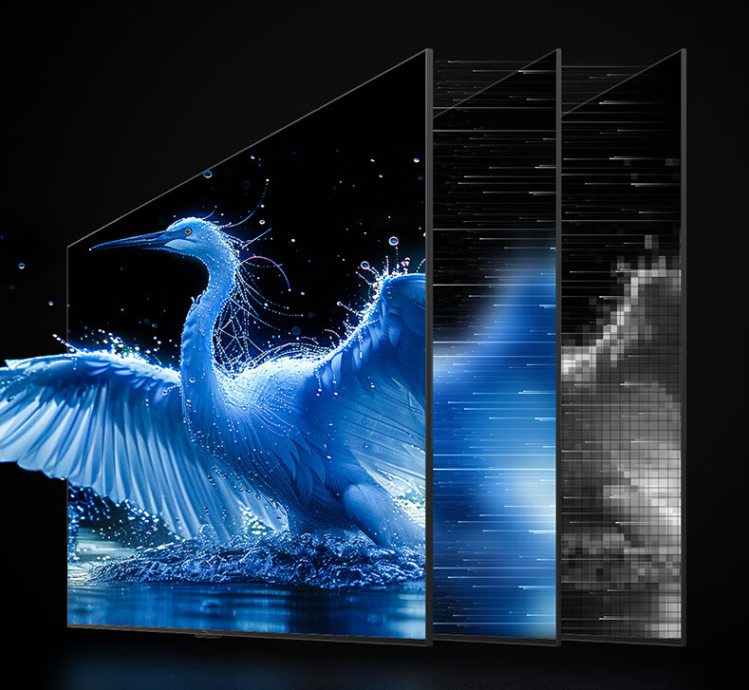
The TCL 2025 FFALCON Crane 7 TV, centered around its exceptional picture quality, features a 4K resolution Mini LED panel that offers a stable 120Hz fluid experience, despite being advertised as a 144Hz overclocked refresh rate, ensuring smooth and detailed visuals without motion blur. With 2736 precise backlight zones and a peak brightness of 2800 nits, it guarantees top-notch contrast and clarity in various lighting environments, making every frame sharp and vivid.
In terms of color performance, this TV covers 95% of the DCI-P3 wide color gamut, delivering rich and accurate colors that bring the real world to life, offering users an immersive visual experience. The audio quality is equally impressive, equipped with a 2.1-channel 7-unit 60W sound system that produces deep bass and crisp highs, creating a truly immersive audio experience.

Connectivity-wise, stays up-to-date with support for Wi-Fi 6 and Bluetooth 5.2 technologies, ensuring high-speed and stable wireless connections, effortlessly handling HD video streams and Bluetooth device pairings. Under the hood, it’s powered by a quad-core MediaTek MT9653 chip, coupled with 4GB of RAM and 128GB of storage, ensuring a smooth system operation and ample room for app installations.
With a comprehensive range of interfaces, including USB-A 3.0/2.0, RJ45, HDMI 2.1/2.0, and AV ports, it fully meets users’ diverse needs for connecting game consoles, audio systems, and other devices, enriching their entertainment lifestyles. In summary, the TCL 2025 FFALCON Crane 7 TV, with its outstanding picture quality, audio, connectivity, and hardware configuration, stands as an ideal choice for those seeking a high-quality home entertainment experience.

What are ESD components, and what is their importance in mobile phones? The significance of built-in ESD components.
ESD components are specialized electronic components designed to protect electronic devices from the effects of electrostatic discharge (ESD). Electrostatic discharge is a sudden release of electrical charge that can potentially damage electronic devices, leading to device malfunctions or a shortened lifespan. ESD components are designed to absorb, conduct, or dissipate electrostatic discharges to prevent damage caused by static electricity.
In mobile phones, the primary role of ESD components is to protect the internal electronic components from the harm caused by electrostatic discharge. Various circuits and components inside the phone are highly sensitive to ESD, which is why multiple ESD components are typically used in the phone’s design to provide protection. These components may include diodes, ESD diode, MOSFET and more.
Specifically, ESD components in a mobile phone may serve the following purposes:
Interface Protection: Various interfaces of the phone, such as the charging port and headphone jack, may require ESD components to prevent damage from electrostatic discharge.
RF Circuit Protection: RF circuits in mobile phones are highly sensitive to ESD and require ESD components to safeguard these critical circuits.
Processor and Memory Protection: Processors, memory, and other crucial components in the phone also require ESD protection to ensure the device’s normal operation.
Touchscreen and Display Protection: The touchscreen and display are integral parts of a mobile phone that also require ESD components to prevent static electricity damage.
In summary, ESD components play a crucial role in protecting the internal electronic components of a mobile phone from damage caused by electrostatic discharge, ensuring the phone’s proper operation and longevity.
Say goodbye to static troubles! A well-known brand in Shenzhen, Crystal Electronics, has developed the TT0311SA-Fx ultra-low capacitance component. It can quickly react within nanoseconds when electrostatic discharge occurs, suppressing surge voltage instantly, ensuring that the phone’s internal RF circuits and/or baseband circuits are not affected by electrostatic discharge. Its low capacitance feature also guarantees interference-free signals, preventing data packet loss and improving call quality.”